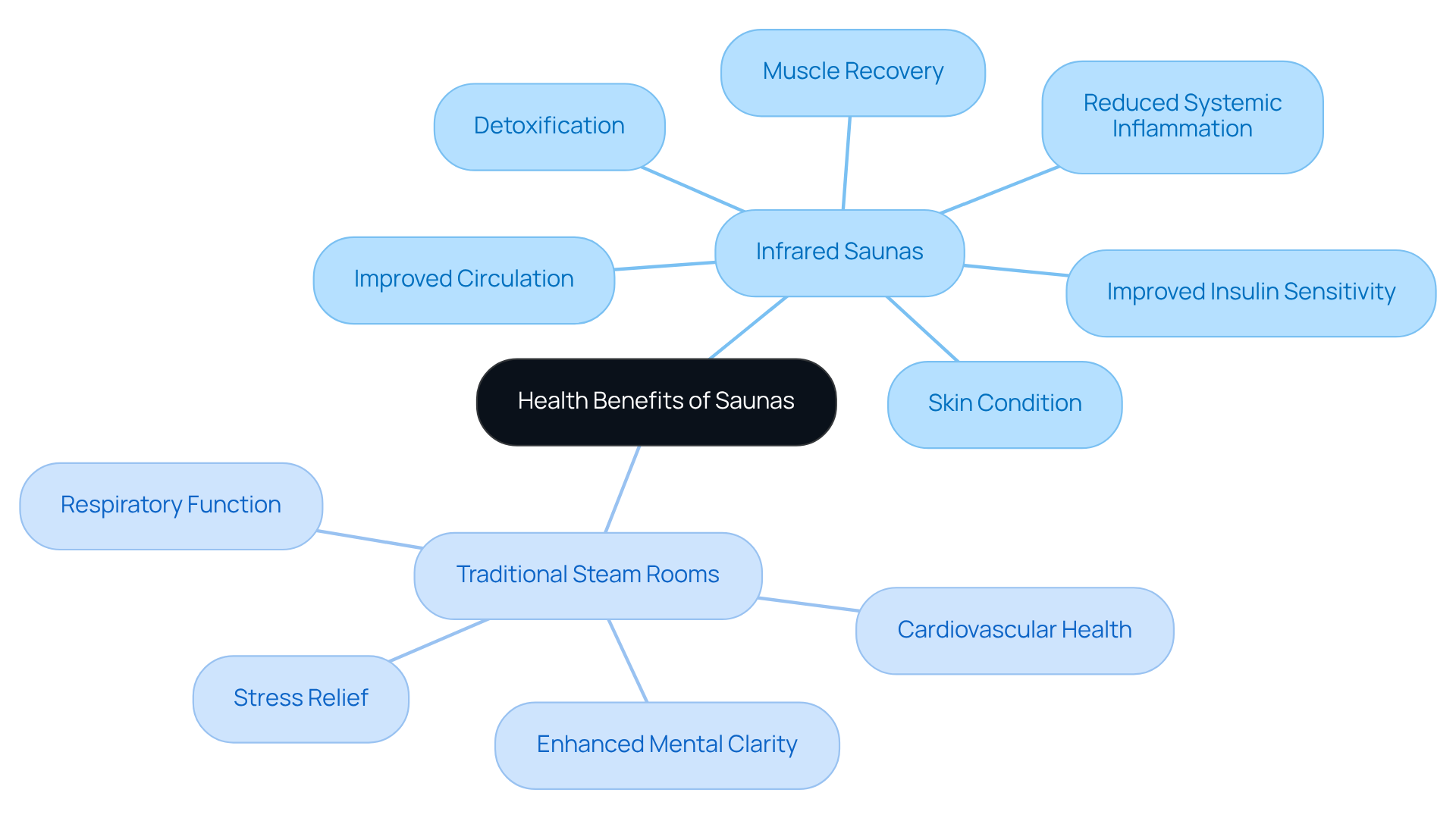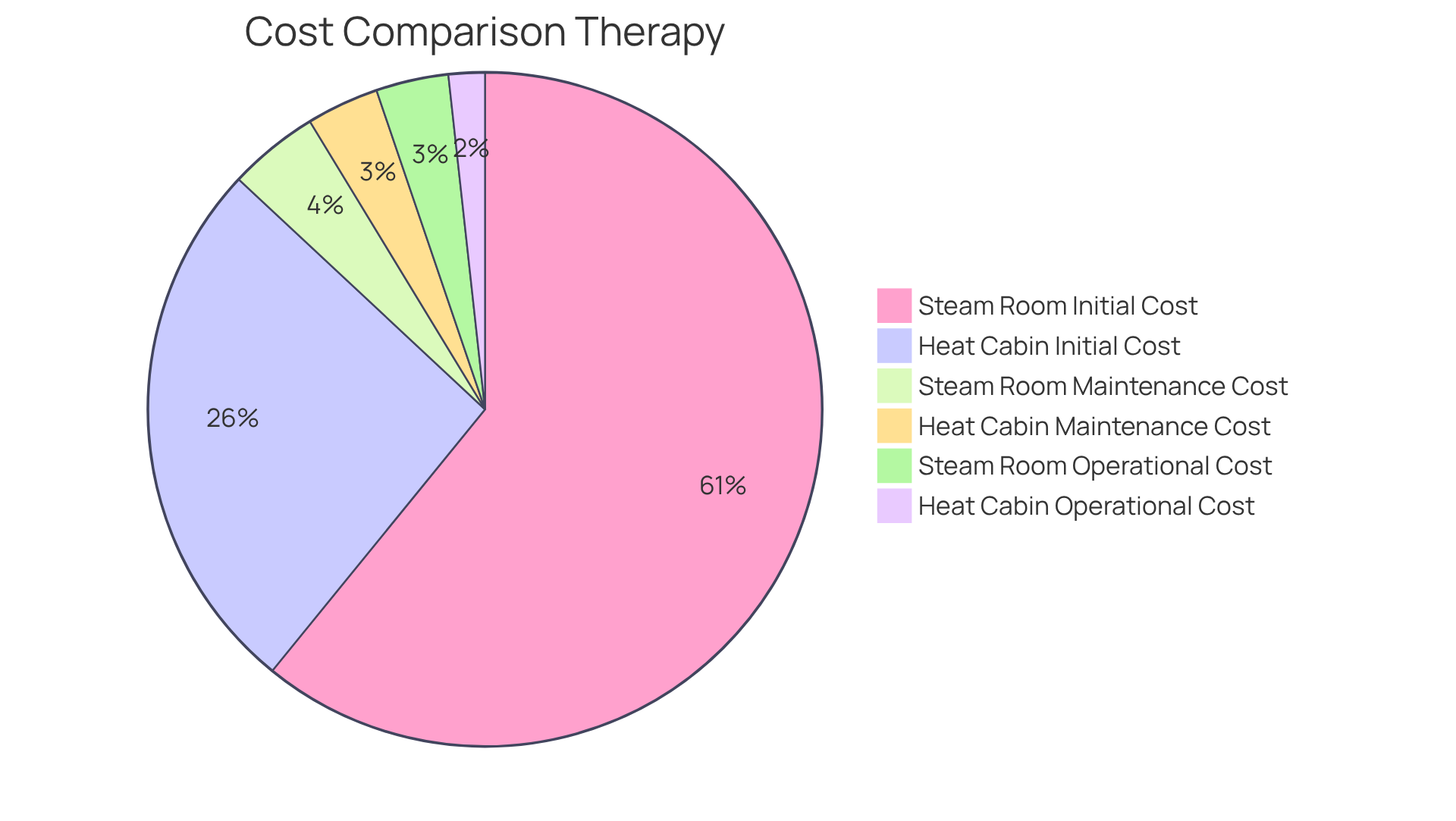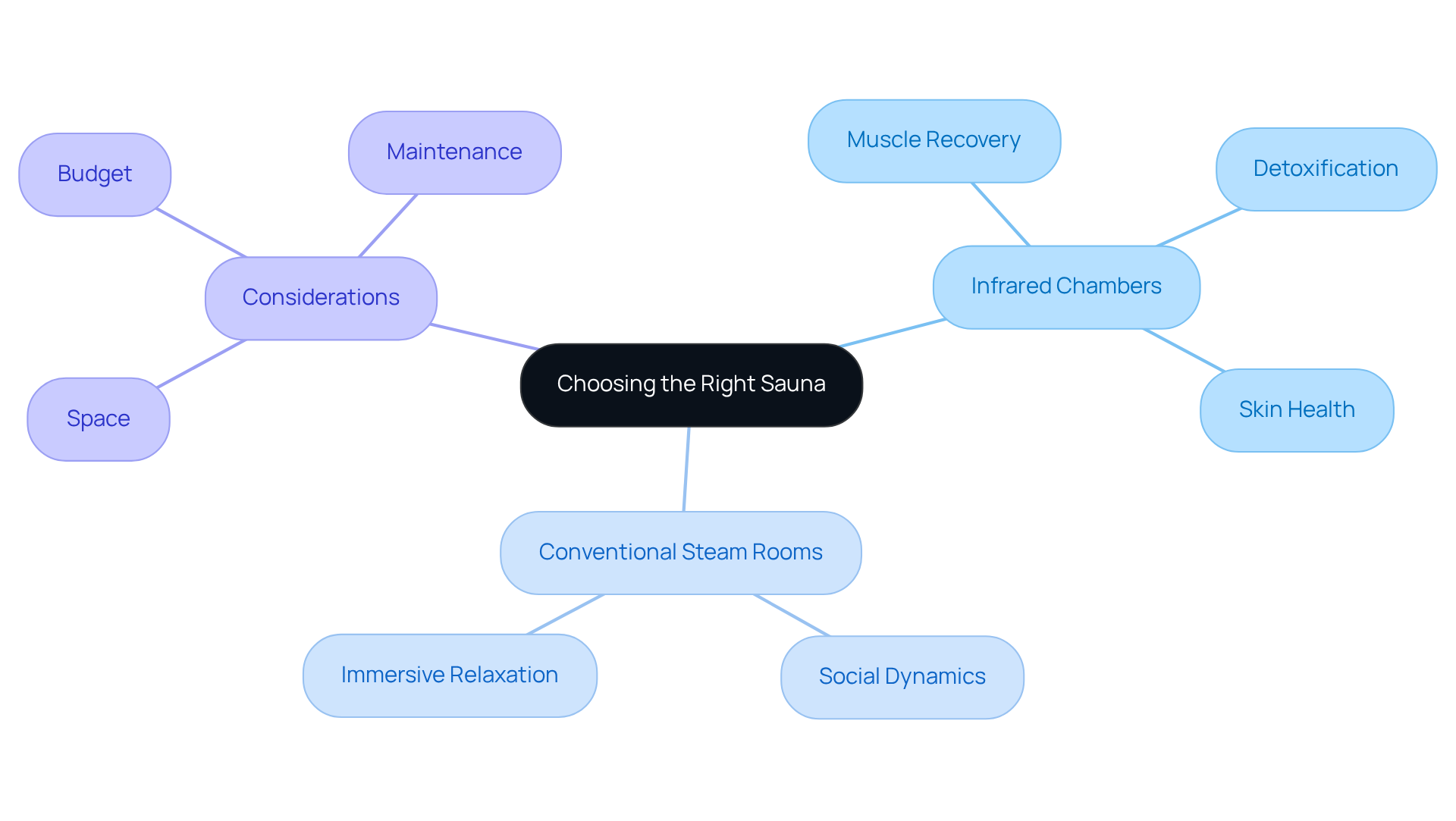Infrared vs. Traditional Saunas: Which is Best for Australia?

Overview
This article provides a comprehensive comparison of infrared and traditional saunas, focusing on their benefits, costs, and suitability for individuals in Australia. The analysis reveals that the optimal choice hinges on personal wellness goals and preferences.
- Infrared saunas deliver gentler heat and deeper tissue benefits, making them ideal for recovery and detoxification.
- In contrast, traditional saunas offer intense heat and relaxation, appealing to those with different health objectives.
Ultimately, understanding these distinctions empowers individuals to make informed decisions tailored to their unique health journeys.
Introduction
The ongoing debate between infrared and traditional saunas has ignited significant interest among wellness enthusiasts in Australia, each presenting distinct benefits tailored to individual health objectives. Infrared saunas offer a gentler, more comfortable experience that fosters detoxification and muscle recovery. In contrast, traditional steam rooms deliver intense heat that enhances relaxation and cardiovascular health.
With both options showcasing compelling advantages, the pivotal question arises: which sauna aligns best with your personal wellness journey? By delving into the nuances of each type, individuals can empower themselves to make informed decisions that effectively support their health and lifestyle choices.
Understanding Infrared and Traditional Saunas
These chambers utilize rays to directly warm the body, typically operating at lower temperatures between 45 and 65°C. This approach offers a more comfortable experience, allowing users to remain longer without feeling overwhelmed by heat. At Tsavo Wellness, our sauna in Australia, the Full Spectrum Heat Sauna, presents a unique opportunity to experience the transformative benefits of thermal light, which raises the body's internal temperature, promoting intense sweating that aids detoxification, enhances metabolism, strengthens the immune system, and improves skin health and complexion. Research indicates that a 20-minute session in a heat therapy room can significantly reduce perceived muscle discomfort following resistance training, making it a preferred choice for athletes and active individuals. Furthermore, regular users report improved sleep quality, attributed to the relaxation response and natural cooling following sessions. Dr. Shah recommends two 30-minute infrared heat therapy sessions weekly for optimal benefits, emphasizing that consistency is more critical than intensity.
Conversely, traditional steam rooms heat the air using a stove and heated stones, creating a humid environment that can reach temperatures of 70 to 100°C. This intense heat exposure fosters relaxation and detoxification, stimulating sweating and enhancing cardiovascular health. Studies suggest that steam bath usage can improve endothelial function, reduce arterial stiffness, and promote normalized blood pressure, making conventional steam baths beneficial for cardiovascular wellness.
Experts note that while both types of steam baths offer distinct advantages, the choice ultimately depends on individual preferences and health goals. Infrared heat rooms, such as those at Tsavo Wellness, are often recommended for individuals seeking a gentler form of heat therapy, particularly beneficial for those sensitive to high temperatures, similar to the experiences offered in sauna Australia. However, individuals with heart conditions, low blood pressure, or infections should consult a physician prior to use. In contrast, traditional steam rooms may appeal to those who enjoy the classic steam experience and the intense heat it provides. Understanding these differences is crucial for making an aligns best with one's wellness journey.

Health Benefits of Infrared vs. Traditional Saunas
Infrared and conventional steam rooms each present a unique array of wellness benefits, operating through distinct mechanisms. Infrared units stand out for their ability to penetrate deeper into tissues, thereby enhancing detoxification, improving circulation, and supporting muscle recovery. Users frequently report significant relief from joint pain and enhanced skin condition, with studies indicating that regular use can lead to reduced systemic inflammation and improved insulin sensitivity. Notably, a cohort study found that engaging in four to seven steam bath sessions weekly resulted in considerable wellness improvements, including enhanced cardiovascular performance and lowered risks of chronic diseases.
Conversely, conventional steam rooms are particularly effective in promoting relaxation and alleviating stress. The intense heat and steam foster an environment conducive to lowering stress hormones, which can enhance mental clarity and overall well-being. Research has demonstrated a correlation between steam bath usage and improved cardiovascular health, revealing a significant inverse relationship between the frequency of steam bathing and fatal cardiovascular events. Additionally, traditional steam rooms can bolster respiratory function, making them beneficial for individuals with conditions such as asthma or COPD.
While both steam room types , the experiences and outcomes vary considerably. Users are encouraged to carefully assess their health objectives—whether they seek muscle recovery, stress relief, or cardiovascular benefits—when choosing between infrared and conventional heat therapy options.

Cost and Maintenance Comparison for Australian Consumers
When assessing expenses, heat therapy cabins present a compelling option with a lower initial acquisition cost, typically ranging from $1,500 to $5,000, influenced by design and features. Their maintenance requirements are also minimal, generally falling between $100 and $250, as these systems operate without water or steam, thus avoiding mold and mildew concerns. Moreover, the operational costs for heat therapy sessions vary from 42 cents to $1.68 each, based on Australian energy rates, rendering them a more economical choice for frequent use.
At Tsavo Wellness in Mosman, Sydney, our state-of-the-art infrared heat therapy experience operates at temperatures between 45°C and 65°C, promoting detoxification and enhancing circulation while providing a premium self-care environment. Clients have the option to include an additional 20 minutes of red light therapy, further amplifying the therapeutic benefits. In contrast, conventional steam rooms often come with higher price tags, ranging from $3,000 to $10,000, and may incur extra costs for installation and maintenance, typically between $150 and $350, due to their reliance on water and higher temperatures. However, the immersive experience offered by conventional steam rooms may be deemed worthwhile by some users, justifying the investment.
Additionally, heat therapy rooms operate at lower temperatures, allowing for extended usage durations and improved user comfort. At Tsavo Wellness, we advocate for clients to arrive hydrated and prepared for detoxification, ensuring a rewarding experience. We also recommend adhering to , such as avoiding showers during sessions and being attuned to one's body for safety. Ultimately, prospective buyers should evaluate the initial expenses against the long-term benefits and maintenance requirements of each heat therapy room type, considering the rising popularity of sauna Australia, influenced by celebrity endorsements and potential wellness advantages.

Choosing the Right Sauna for Your Wellness Journey
Choosing the perfect steam room is a pivotal decision influenced by personal wellness goals, individual preferences, and lifestyle considerations. For those prioritizing a gentler heat experience with deeper tissue benefits, infrared chambers emerge as the optimal choice. These units are particularly effective for muscle recovery, detoxification, and enhancing skin health, making them a preferred option among athletes and health-conscious individuals. Conversely, conventional steam rooms appeal to those who appreciate the ritualistic aspects of steam and elevated temperatures, offering a more immersive relaxation experience.
Consider real-life examples that underscore this choice:
- Layla Kalachm, a resident of Sydney, invested in an infrared device to streamline her wellness routine and eliminate costly gym visits, showcasing the convenience and flexibility these units provide.
- In contrast, many users cherish the social dynamics of conventional steam rooms, which foster community and relaxation.
When selecting between types of , it is crucial to consider factors such as available space, budget, and maintenance requirements. Wellness coaches often advise clients to align their heat therapy selection with specific health objectives, whether that pertains to muscle recovery, stress relief, or overall wellness enhancement. Ultimately, the right sauna in Australia can play a significant role in a holistic wellness journey, designed to meet individual needs and lifestyles.

Conclusion
Choosing between infrared and traditional saunas necessitates a clear understanding of the distinct benefits each type offers and how they correspond with personal wellness objectives. Infrared saunas deliver a gentler, deeper heat experience, ideal for detoxification, muscle recovery, and skin health, making them particularly attractive for those focused on these outcomes. Conversely, traditional steam rooms provide intense heat that fosters relaxation and cardiovascular health, appealing to individuals who value the classic steam experience.
Key insights throughout the article emphasize the advantages of both sauna types:
- Infrared saunas are often more cost-effective regarding initial investment and maintenance.
- Traditional saunas may offer a more immersive and social atmosphere.
- Health benefits differ, with infrared saunas excelling in muscle recovery and detoxification.
- Traditional saunas enhance relaxation and cardiovascular function.
Grasping these distinctions is crucial for making an informed choice that aligns with personal health and wellness journeys.
Ultimately, the decision should reflect personal preferences, health objectives, and lifestyle considerations. Whether one opts for the soothing warmth of an infrared sauna or the enveloping steam of a traditional sauna, the right choice can significantly elevate overall well-being. Embracing the benefits of these heat therapies can lead to improved health outcomes, making it essential to explore available options and invest in a sauna experience that resonates with personal wellness aspirations.
Frequently Asked Questions
What is the main difference between infrared saunas and traditional steam rooms?
Infrared saunas use rays to directly warm the body at lower temperatures (45 to 65°C), providing a more comfortable experience, while traditional steam rooms heat the air with a stove and heated stones, reaching higher temperatures (70 to 100°C) and creating a humid environment.
What are the benefits of using an infrared sauna?
Infrared saunas promote intense sweating that aids detoxification, enhances metabolism, strengthens the immune system, and improves skin health. They can also reduce muscle discomfort after exercise and improve sleep quality.
How often should one use an infrared sauna for optimal benefits?
Dr. Shah recommends two 30-minute infrared heat therapy sessions weekly for optimal benefits, emphasizing that consistency is more critical than intensity.
What are the health benefits associated with traditional steam rooms?
Traditional steam rooms can improve endothelial function, reduce arterial stiffness, and promote normalized blood pressure, making them beneficial for cardiovascular wellness.
Who should consider using infrared saunas?
Infrared saunas are often recommended for individuals seeking a gentler form of heat therapy, particularly those sensitive to high temperatures. However, individuals with heart conditions, low blood pressure, or infections should consult a physician before use.
What should someone consider when choosing between an infrared sauna and a traditional steam room?
The choice depends on individual preferences and health goals. Infrared saunas are suitable for those seeking milder heat, while traditional steam rooms may appeal to those who enjoy intense heat and the classic steam experience.


